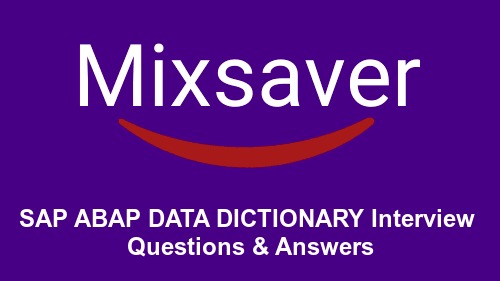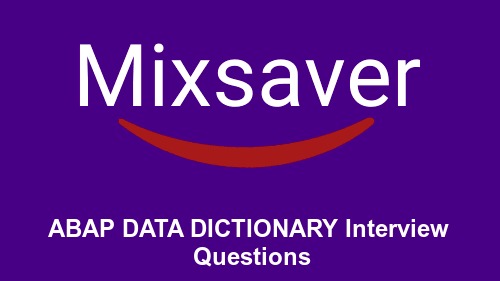1. What are the layers of data description in R/3?
• The external layer.
• The ABAP/4 layer.
• The database layer.
2. Define external layer?
The external layer is the plane at which the user sees and interacts with the data, that is, the data format in the user interface. This data format is independent of the database system used.
3. Define ABAP/4 layer?
The ABAP/4 layer describes the data formats used by the ABAP/4 processor.
4. Define Database layer?
The database layer describes the data formats used in the database.
5. What is a Data Class?
The Data class determines in which table space the table is stored when it is created in the database.
6. What is a Size Category?
The Size category describes the probable space requirement of the table in the database.
7. How many types of size categories and data classes are there?
There are five size categories (0-4) and 11 data classes only three of which are appropriate for application tables:
• APPL0- Master data (data frequently accessed but rarely updated).
• APPL1- Transaction data (data that is changed frequently).
• APPL2- Organizational data (customizing data that is entered when the system is configured and then rarely changed).
The other two types are:
• USR
• USR1 – Intended for customer's own developments.
8. What are control tables?
The values specified for the size category and data class are mapped to database-specific values via control tables.
9. What is the function of the transport system and workbench organizer?
The function of the transport system and the Workbench Organizer is to manage any changes made to objects of the ABAP/4 Development Workbench and to transport these changes between different SAP systems.
10. What is a table pool?
A table pool (or pool) is used to combine several logical tables in the ABAP/4 Dictionary. The definition of a pool consists of at least two key fields and a long argument field (VARDATA).
11. What are pooled tables?
These are logical tables, which must be assigned to a table pool when they are defined. Pooled tables can be used to store control data (such as screen sequences or program parameters).
12. What is a table cluster?
A table cluster combines several logical tables in the ABAP/4 Dictionary. Several logical rows from different cluster tables are brought together in a single physical record. The records from the cluster tables assigned to a cluster are thus stored in a single common table in the database.
13. How can we access the correction and transport system?
Each time you create a new object or change an existing object in the ABAP/4 Dictionary, you branch automatically to the Workbench Organizer or correction and transport system.
14. Which objects are independent transport objects?
Domains, Data elements, Tables, Technical settings for tables, Secondary indexes for transparent tables, Structures, Views, Matchcode objects, Matchcode Ids, Lock objects.
15. How is conversion of data types done between ABAP/4 & DB layer?
Conversion between ABAP/4 data types and the database layer is done within the database interface.
16. How is conversion of data types done between ABAP/4 & external level?
Conversion between the external layer and the ABAP/4 layer is done in the SAP dialog manager DYNP.
17. What are the Data types of the external layer?
ACCP, Char, CLNT, CUKY, CURR, DATS, DESC, FLTP, INT1, INT2, INT4, LANG, LCHR, LRAW, NUMC, PREC, QUAN, RAW, TIMS, UNIT,VARC.
18. What are the Data types of the ABAP/4 layer?
Possible ABAP/4 data types:
C: Character.
D: Date, format YYYYMMDD.
F: Floating-point number in DOUBLE PRECISION (8 bytes).
I: Integer.
N: Numerical character string of arbitrary length.
P: Amount of counter field (packed; implementation depends on h/w platform).
S: Time Stamp YYYYMMDDHHMMSS.
V: Character string of variable length, length is given in the first two bytes.
X: Hexadecimal (binary) storage.
19. How can we set the table spaces and extent sizes?
You can specify the extent sizes and the table space (physical storage area in the database) in which a transparent table is to be stored by setting the size category and data class.
20. What is the function of the correction system?
The correction system manages changes to internal system components. Such as objects of the ABAP/4 Dictionary.
21. What are local objects?
Local objects (Dev class$TMP) are independent of correction and transport system.
22. What is a Development class?
Related objects from the ABAP/4 repository are assigned to the same development class. This enables you to correct and transport related objects as a unit.
23. What is a data dictionary?
Data Dictionary is a central source of data in a data management system. Its main function is to support the creation and management of data definitions. It has details about
• What data is contained?
• What are the attributes of the data?
• What is the relationship existing between the various data elements?
24. What functions does a data dictionary perform?
In a data management system, the principal functions performed by the data dictionary are
• Management of data definitions.
• Provision of information for evaluation.
• Support for s/w development.
• Support form documentation.
• Ensuring that the data definitions are flexible and up-to-date.
25. What are the features of ABAP/4 Dictionary?
The most important features are:
• Integrated to aABAP/4 Development Workbench.
• Active in the runtime environment.
26. What are the uses of the information in the Data dictionary?
The following information is directly taken from the Data dictionary:
• Information on fields displayed with F1 help.
• Possible entries for fields displayed with F4 help.
• Matchcode and help views search utilities.
27. What are the basic objects of the data dictionary?
• Tables
• Domains
• Data elements
• Structures
• Foreign Keys
28. What are the aggregate objects in the data dictionary?
• Views
• Match codes
• Lock objects.
29. In the ABAP/4 Dictionary Tables can be defined independent of the underlying database (T/F).
True.
30. ABAP/4 Dictionary contains the Logical definition of the table.
31. A field containing currency amounts (data type CURR) must be assigned to a reference table and a reference field. Explain.
As a reference table, a system containing all the valid currencies is assigned or any other table, which contains a field with the currency key format. This field is called as reference field. The assignment of the field containing currency amounts to the reference field is made at runtime. The value in the reference field determines the currency of the amount.
32. A field containing quantity amounts (data type QUAN) must be assigned to a reference table and a reference field. Explain?
As a reference table, a system table containing all the valid quantity units is assigned or any other table, which contains a field with the format or quantity units (data type UNIT). This field is called as reference field.
The assignment of the field containing quantity amounts to the reference field is made at runtime. The value in the reference field determines the quantity unit of the amount.
33. What is the significance of Technical settings (specified while creating a table in the data dictionary)?
By specifying technical settings we can control how database tables are created in the database. The technical settings allows us to
• Optimize storage space requirements.
• Table access behavior.
• Buffering required.
• Changes to entries logged.
34. What is a Table attribute?
The table's attributes determine who is responsible for maintaining a table and which types of access are allowed for the table. The most important table attributes are:
• Delivery class.
• Table maintenance allowed.
• Activation type.
35. What is the significance of Delivery Class?
• The delivery class controls the degree to which the SAP or the customer is responsible for table maintenance.
• Whether SAP provides the table with or without contents.
• Determines the table type.
• Determines how the table behaves when it is first installed, at upgrade, when it is transported, and when a client copy is performed.
36. What is the max. no. Of structures that can be included in a table or structure.
Nine.
37. What are two methods of modifying SAP standard tables?
• Append Structures and
• Customizing Includes.
38. What is the difference between a Substructure and an Append Structure?
• In case of a substructure, the reference originates in the table itself, in the form of a statement include….
• In case of an append structure, the table itself remains unchanged and the reference originates in the append structure.
39. To how many tables can an append structure be assigned.
One.
40. If a table that is to be extended contains a long field, we cannot use append structures why?
Long fields in a table must always be located in the end, as the last field of the table. If a table has an append structure the append line must also be on the last field of the table.
41. Can we include customizing include or an append structure with Pooled or Cluster tables?
No.
42. What are the two ways for restricting the value range for a domain?
• By specifying fixed values.
• By stipulating a value table.
43. Structures can contain data only during the runtime of a program (T/F)
True.
44. What are the aggregate objects in the Dictionary?
• Views
• Match Code.
• Lock Object.
45. What are base tables of an aggregate object?
The tables making up an aggregate object (primary and secondary) are called aggregate object.
46. The data of a view is not physically stored, but derived from one or more tables (t/f)
True.
47. What are the 2 other types of Views, which are not allowed in Release 3.0?
• Structure Views.
• Entity Views.
48. What is a Match Code?
Match code is a tool to help us to search for data records in the system. Match Codes are an efficient and user-friendly search aid where key of a record is unknown.
49. What are the two levels in defining a Match Code?
• Match Code Object.
• Match Code Id.
50. What is the max no of match code Id's that can be defined for one Match code object?
A match code Id is a one character ID that can be a letter or a number.
51. Can we define our own Match Code ID's for SAP Matchcodes?
Yes, the number 0 to 9 are reserved for us to create our own Match Code Ids for a SAP defined Matchcode object.
52. What is an Update type with reference to a Match code ID?
If the data in one of the base tables of a matchcode ID changes, the matchcode data has to be updated. The update type stipulates when the matchcode is to be updated and how it is to be done. The update type also specifies which method is to be used for Building matchcodes. You must specify the update type when you define a matchcode ID.
53. Can matchcode object contain Ids with different update types?
Yes.
54. What are the update types possible?
The following update types are possible:
• Update type A: The matchcode data is updated asynchronously to database changes.
• Update type S: The matchcode data is updated synchronously to database changes.
• Update type P: The matchcode data is updated by the application program.
• Update type I: Access to the matchcode data is managed using a database view.
• Update type L: Access to the matchcode is achieved by calling a function module.
55. What are the two different ways of building a match code object?
A match code can be built in two different ways:
• Logical structure: The matchcode data is set up temporarily at the moment when the match code is accessed. (Update type I, k).
• Physical Structure: The match code data is physically stored in a separate table in the database. (Update type A, S, P).
56. What are the differences between a Database index and a match code?
• Match code can contain fields from several tables whereas an index can contain fields from only one table.
• Match code objects can be built on transparent tables and pooled and cluster tables.
57. What is the function of a Domain?
• A domain describes the technical settings of a table field.
• A domain defines a value range, which sets the permissible data values for the fields, which refers to this domain.
• A single domain can be used as basis for any number of fields that are identical in structure.
58. Can you delete a domain, which is being used by data elements?
No.
59. What are conversion routines?
• Non-standard conversions from display format to sap internal format and vice-versa are implemented with so called conversion routines.
60. What is the function of a data element?
A data element describes the role played by a domain in a technical context. A data element contains semantic information.
61. Can a domain, assigned to a data element be changed?
Yes. We can do so by just overwriting the entry in the field domain.
62. Can you delete data element, which is being used by table fields.
No.
63. Can you define a field without a data element?
Yes. If you want to specify no data element and therefore no domain for a field, you can enter data type and field length and a short text directly in the table maintenance.
64. What are null values?
If the value of a field in a table is undefined or unknown, it is called a null value.
65. What is the difference between a structure and a table?
Structures are constructed the almost the same way as tables, the only difference using that no database table is generated from them.
66. What is a view?
A view is a logical view on one or more tables. A view on one or more tables i.e., the data from a view is not actually physically stored instead being derived from one or more tables.
67. How many types of Views are there?
• Database View
• Help View
• Projection View
• Maintenance View
68. What is Locking?
When two users simultaneously attempt to access the same data record, this is synchronized by a lock mechanism.
69. What is database utility?
Database utility is the interface between the ABAP/4 Dictionary and the underlying the SAP system.
70. What are the basic functions of Database utility?
The basic functions of database utility are:
• Create database objects.
• Delete database objects.
• Adjust database objects to changed ABAP/4 dictionary definition.
71. What is Repository Info. Systems?
It is a tool with which you can make data stored in the ABAP/4 Dictionary available.





